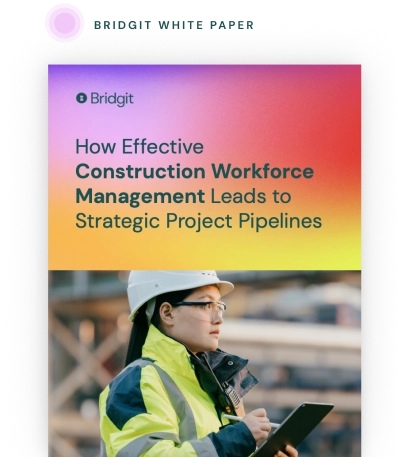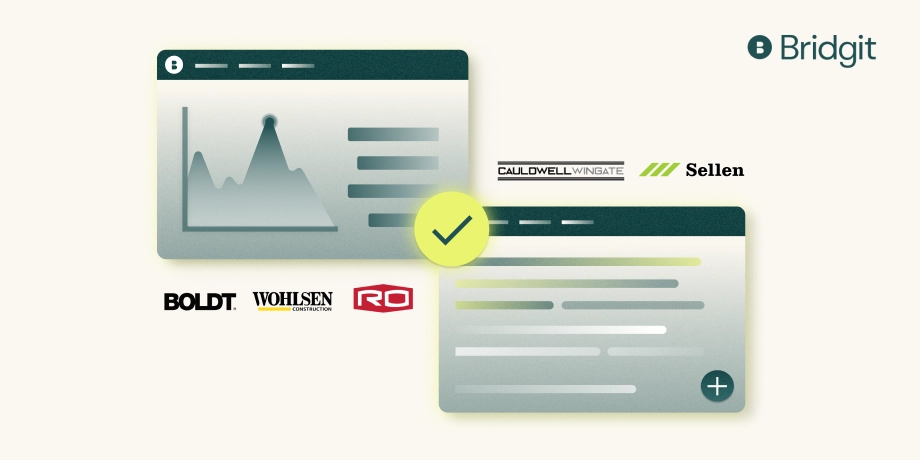Table of Contents
Modern contractors thrive when making data-driven decisions. One of the biggest questions regarding quality data in construction revolves around the workforce, its availability, and where it needs to be. Using spreadsheets to make key business decisions about allocating people to jobs, communicating updates, and forecasting future labor demands is like juggling underwater; it just can’t happen.
Our customers understand this and use the insights from Bridgit Bench to make better strategic business decisions that help them win bids, optimize their teams, and collaborate successfully. Don’t just take our word for it; hear it directly from them.
Forecasting and Confidence
Arguably, the most difficult thing to do with your workforce is to forecast labor demands weeks, months, and years in advance, especially for projects you’re pursuing or would like to pursue.
Labor forecasting is incredibly complex, regardless of the size of a contractor’s workforce, and the tools that can provide accurate foresight didn’t exist for the longest time. It would be like trying to loosen a bolt before a wrench existed. There might’ve been a way, but it will likely just waste your time.
But, like wrenches, Bridgit Bench exists. Just like that, you have foresight; with it, you can be more strategic about your work without being handcuffed to a spreadsheet for hours.
Rogers-O’Brien
Bridgit Bench has altered the way Rogers-O’Brien conducts their meetings. As Johnathon Grammer, Director of Operational Excellence, tells us, moving from Excel to Bridgit Bench has been transformative. “It was the same meeting we had before when it was Excel spreadsheets. Now, they can spend about 15 minutes going through the “what-if” scenario, and then they spend about 45 minutes talking about the existing projects, issues, and needs. It’s bought us back 45 minutes with some very expensive resources.”
The newfound efficiency isn’t just about saving time and making strategic decisions. As their planning improved, Rogers O’Brien could pick up more projects than they normally would have because they didn’t have to worry about the risk of not having the resources to complete the job. Grammar told us they’re more willing to “place bets now because, in workforce planning meetings, they’re covering much of the topics they should have been covering when they weren’t able to.”
Read Rogers-O’Brien’s full story.
Wohlsen Construction
For Wohlsen, Bridgit Bench has been pivotal in gaining insights into their project pursuits. Excel’s once complex “what-if scenarios” are now streamlined: “In Bridgit Bench, what-if scenarios are easy to put in place. We can see the impact, learn on the fly, and make quicker decisions. I think that the speed to the decision that Bench gives us has helped in planning and determining go/no-go scenarios. We can ensure that we have the talent to put on the project to be successful for ourselves and also for the clients.”
The complexity of construction projects often bogs decision-making, and stress increases as that slows down. Making decisions on the fly with the utmost confidence in your data is vital to profitability and nurturing the relationships between you and your clients.
The Boldt Company
Boldt’s experience has been one of continuous evolution. Initially seeking a more straightforward approach to staffing projects and filling vacancies, Jeremy Moe, Operations Manager at Boldt, quickly saw the strategic value of Bench:
“Our meetings are less about getting the information into the system and more about strategy, which has been fantastic. We strategize how to fill vacant roles on a project or where there might be pockets in our business where someone isn’t fully utilized. We can grab onto them and avoid hiring another person since we can see that someone has the capacity to take on some more work”
One of the major costs for contractors is turnover and hiring. The costs associated with this only increase when you factor in the skilled labor shortage and the time it takes to recruit, hire, and retain quality employees.
Collaboration
A key question in how a contractor can make better business decisions is: how are we collaborating on this problem?
While it seems counterintuitive, having a lot of stakeholders in a project doesn’t automatically translate into a collaborative utopia. Usually, it means information gets stuck in silos, bottlenecked in bureaucracy, or simply lost in the noise of other data.
Sellen Construction
When it comes to your workforce, your most expensive and important asset, you can’t afford to have a stifled collaborative environment. Sellen Construction used Bench to usher in a new level of collaboration into their company. Jamie Miller, Director of Engineering Development, told us Bridgit Bench “really helps to foster collaboration because everyone can see when I’ve assigned an engineer to a project and offer feedback about their working relationship with the other team members.”
Those strong teams help Sellen stay competitive when bidding on projects.
“I think we’re building better teams from the inception of the project. We have the RFP in-hand and we’re all on the same platform, we’re collaborating better on what team we’re building right away.”
A strong team can ultimately determine whether you win or lose a project.
Cauldwell Wingate
Better collaboration is a consistent theme we hear from our customers. And that’s because Bridgit Bench has given contractors a new way to see their workforce.
For Cauldwell Wingate, collaboration improved among management and between management and project teams. Lisa Villasmil, Vice President of People & Culture, told us, “Having a meeting where we can come together and look at one screen and the same real-time information is paramount. Now when we’re collaborating on staffing we can just say ‘Check Bench. What does it say in Bench?’ That has really made us more efficient when having staffing discussions and has helped foster a more collaborative relationship between the project team and People Operations.”
Again, collaboration breeds better decision-making, which lets you “keep a tighter roster and automatically yield cost savings.”
Read Cauldwell Wingate’s full story
Holistic business impact
We’ll often get asked what the ROI is for Bridgit Bench. The benefits are numerous across broad categories, and Morgan Traynor, the former Senior Director of Operational Excellence at Ryan Companies, outlined it best:
“The ROI for Bridgit Bench can be calculated through four main components. Manager efficiency, reduction of new hire costs, proactive and accurate workload leads, and increased profits.”
But if that’s not clear enough, let Johnathon Grammer tell you:
“If you’re not using Bridgit Bench, you might be leaving money on the table, or unintendedly leaving it on the bench.”

Use your workforce data to create a competitive advantage
Download our white paper to see how effective workforce planning can help stay ahead of labor demands and create a strategic project pipeline.


